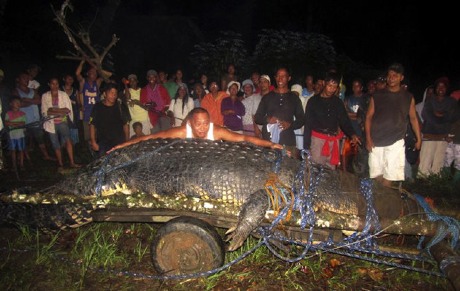Lolong, the giant crocodile captured in the Philippine province of Agusan del Sur last September 2011 was recognised by the Guinness Book of World Records as the world’s largest crocodile in captivity.
Mayor Edwin Cox Elorde said dozens of villagers and experts ensnared the 21-foot (6.4-meter) male crocodile along a creek in Bunawan township in Agusan del Sur province after a three-week hunt. It could be one of the largest crocodiles to be captured alive in recent years, he said, quoting local crocodile experts.
Elorde said the crocodile killed a water buffalo in an attack witnessed by villagers last month and was also suspected of having attacked a fisherman who went missing in July.

[Photo courtesy Yahoo! News.]
A second crocodile is reportedly still on the loose in the area and is being hunted down by local residents.
| SUPPORT INDEPENDENT SOCIAL COMMENTARY! Subscribe to our Substack community GRP Insider to receive by email our in-depth free weekly newsletter. Subscribe to our Substack newsletter, GRP Insider! Learn more |
Corocodiles are often cast in a bad light in the Philippines as Filipinos use these animals to describe local and national politicians. Buwaya is the Tagalog word for crocodile and the term is almost always made synonymous with Filipino politicians. For example, Philippine Senator Tefisto “TG” Guingona III ran for office in 2010 mouthing the tag line “Galit sa buwaya!†which literally translates to “Angry at crocodiles!” symbolising his campaign to supposedly rid the government of corrupt officials.

[Photo courtesy EpalWatch.com.]
Unlike corrupt Filipino politicians, however, many crocodiles are an endangered species. Lolong’s kind, crocodylus porosus commonly known as the saltwater crocodile may be thriving in northern Australia and India, but is now almost extinct across much of southeast Asia.
benign0 is the Webmaster of GetRealPhilippines.com.
Mayor Elorde and his ilks should be made to explain instead of why the Agusan Marsh is rapidly destroyed and occupied illegaly by squatters threatening migratory and endemic wild life. The place is depressed. When the logging industry left, it took with them everything except the politicians. It seems the local politicians there posses more reptilian DNA than those giant amphibians.
No one really gives a hoot since priorities are so whack with these people.